#(history class lol)
Explore tagged Tumblr posts
Text
Anyone else thinking about how odd the hermitcraft economy is?
in season 9 they had a minor economic recession after the diamond ore war because there were far too many diamonds in circulation making them (hypothetically) worth less than normal and ren stepped in as the king and did what has been done in the midst of a lot of irl economic depressions; he created a government so they could employ the policy of Keynesian economics (basically more gov't intervention to stabilize the economy, it mostly worked in 1930's japan!), he took control of diamonds and even introduced a new currency, royal emeralds (much like Germany after WW1! they had some hyperinflation because of the war reparations they had to pay and the gov't not understanding that printing more money makes the money worth less resulting in the mark [currency] being so worthless they started burning it because they couldn't afford wood for fires. a new gov't came into power and they replaced the mark with rentenmarks which did a lot of fixificating for the economy). Ren's gov't also introduced a lot of gov't funded projects like the quests (the irl equivalent for this would be Roosevelt's New Deal which introduced policies/projects called the Alphabet Agencies (among other things) such as the AAA, CCC, TVA (do you see why they're called the alphabet agencies?) that would adjust the value of grain so farmers could start earning money for produce again and create work that would support a growing economy, projects like building roads and bridges)
so basically, all the policies ren's government introduced were very logically sound and worked in real life to fix the economy (except that irl the Great Depression only fully ended because WW2 started-), the issue is that hermitcraft is not real life and hermits do not behave like real people, they behave like hermits.
lets start with the hermitcraft economy. unlike the real economy, hermits rarely adjust prices according to how many diamonds are "in circulation". i say this despite the fact grian in a recent-ish episode says that "everything costs more this season because diamonds are more common". that can't be true because the caves and cliffs update literally made diamonds more difficult to acquire. I will circle back to this point made by grian later
hermits not adjusting prices by server-wide abundance of diamonds (because they cant really know how much anyone has, much less the total amount of diamonds in circulation, they just know who has a lot and who is broke) means that more diamonds doesn't make them worth less like it did with German marks, it just means hermits have more expendable currency and can spend more money and less time gathering materials for projects. It is also notable that diamonds are constantly being added and taken out of circulation because they're an actual useful currency rather than real life currencies which are symbolic slips of paper. diamonds can be used for armour and tools and it can be acquired by mining. so because of how hermits spend money, taking diamonds out of the economy in s9 did nothing but make them poor and angry at the government. the hermitcraft economy is actually stronger with more diamonds in circulation and is worsened by gov't intervention.
so already the use of real life strategies is utterly useless in hermitcraft economy but there are a few other reasons as well
the hermits tendency to resist government as well as the flawed and greedy government itself are a couple but also the fact that all the hermits are self employed (in real life but also in universe). they own and stock their own shops meaning all profits are more or less direct; its not passed through hands of big corporations so the person producing the product gets mere cents. the hermits are essentially small business owners (which becomes a bit of a problem come season 10 but we're still talking about season 9). The important part is the self employment. the season 9 gov't introduces the quests which mimic and echo real life government funded projects but because they're all employed and the quests gave small amounts of diamonds back, they did very little for the hermits
I'm sure theres more to say but i think its time to move on to the very interesting season 10 economy
if you've missed it you must be living under a rock but hermits are all using permits this season meaning only one shop in the shopping district is selling any given item/material and as a result of this prices have gone sky high. at one point a single stack of mangrove logs cost 7 diamonds when in previous seasons you could get at least 1 stack of wood for 1 diamond if not more
So what is causing this economic depression and hyperinflation?
well, circling back to the point grian made about resources costing more because of abundance of diamonds, I would think it actually costs more because of the permits.
grian thinks the diamond prices are fair because he has middle of the road permits (and is one of the hermits who designed their shopping district, permit and economic system this season so he's biased), there is enough demand to keep him afloat when he's stocked but its nothing people are clamouring for and buying him out. on the other hand, joel made a lot of shops that no one shops at because his objectively weighted permits have not been selling as well as they anticipated when making the permits (also some people like etho and pearl have additional income from their not as fabulous permits because they've made a pay to play game to go with it) and finally there are hermits like mumbo whose gold, iron and item frame shops were constantly getting bought out so he was frustrated with trying to restock despite getting lots of profit
(another interesting dynamic to think about is permits like cleo's book permit which lost value as the season went on because everyone needed books early on but now that they're all playing late game Minecraft, everyone is pretty stocked up and buying from cleo less often)
Basically, grian is satisfied with the pricing because he's middle class and couldn't afford it if they were more expensive but appreciates not being constantly out of stock, joel is unsatisfied because he is lower class and never has enough expendable currency to fund his projects because materials are too expensive and his permits aren't worth enough to sell them for more, and mumbo is unsatisfied because he is higher class and is constantly out of stock because his materials sell out too often and he wants to sell them for more to stay in stock more (classic supply and demand, he doesn't want to stock them as often making the supply lower and the demand proportionally higher making them worth more and therefore more expensive)
the reason i say the permits are to blame for the high prices is because they cause the responsibility of constantly stocking something to fall on one person (in past seasons, if one persons sandstone shop was out of stock you could go check someone else's sandstone shop). the threat of taking the permit away if they arent stocked along with the difficulty of constantly stocking some of these materials raises the cost.
a great example of this is skizzleman because his mangrove and cherry wood shop was one of the first shops to be built in the shopping district, meaning he somewhat set the prices this season. now, mangrove and cherry are both difficult trees to harvest because of their unconventional shapes and the fact that they are more recent additions (and skizz's stubborn desire to design his own farms...) so because of the time required to gather them the prices already were hitched up. add that to the fact that they are trying to constantly be in stock and therefore low prices that allow hermits to completely buy out the shops are unfavourable, and you get sky rocket-ing prices. (it is also difficult because skizz had no prior experience with hermitcraft pricing)
in conclusion... hermitcraft needs a laissez-faire economy (f. a. hayek) to function and not go into economic depression. Between the nature of the diamond currency, hermits' tendency to rebel against governments, the way they use the concept of supply and demand to price their goods, and the restrictions permits put on supplying products, hermits have proven that extensive structure and government intervention have not improved economic wellbeing the way that it does in real life
thus, hermits do not behave like regular humans, they operate on fae laws of its funny so lets do it and therefore must be governed as such (aka not governed), thank you for coming to my ted talk
#i am by no means an expert#this is all the result of knowledge from high school history class#and too much time on my hands#lol#rants/lectures#pixls things#hermitcraft season 10#hermitcraft season 9#hermitcraft#renthedog#rendog#rentheking#grian#joel smallishbeans#smallishbeans#mumbo jumbo#ethoslab#geminitay#zombiecleo#skizzleman#hc s10#hermitcraft 10#hermitblr#hermitcraft smp#hc 10#hermitcraft s10#hermitcraft 9#hermitcraft s9#hc s9#hc 9
3K notes
·
View notes
Text

Turbo Granny blunt rotation WIP
#for a class assignment due todayyyy#still gotta edit the fucking 600 word description yuck#and write another essay for a different class#and read another manga chapter for that class#and do makeup readings/hw for my mesoamerican art history class plus the readings/hw for this week#and i haven't been sleeping more than like 4 hrs a night cause i started a new medication#which also gives me evening heart palpitations lol#and im skipping class to finish as much as i can#but eventually ill clean this up and color it!#eventually#hopefully#next term i snagged a spot in the only 2D animation class this stupid college has ever had#and set up my schedule to only take up 3 days despite having 4 classes#and hopefully 2 of said classes will be pretty easy#ones a 1x a week gardening thing and the others an online design class#i wanted to leave lots of time to animate#dandadan#turbo granny#animation#fanart#dandadan fanart#character turnaround#art#digital art#artists on tumblr#trans artist#my art#my animations#krita#tw drugs
917 notes
·
View notes
Text

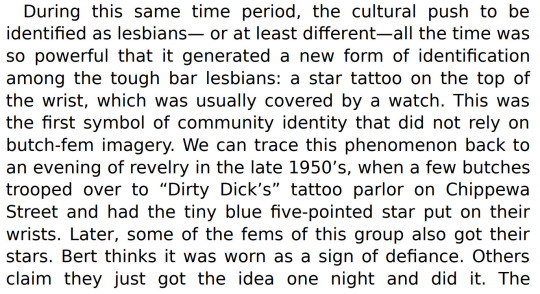

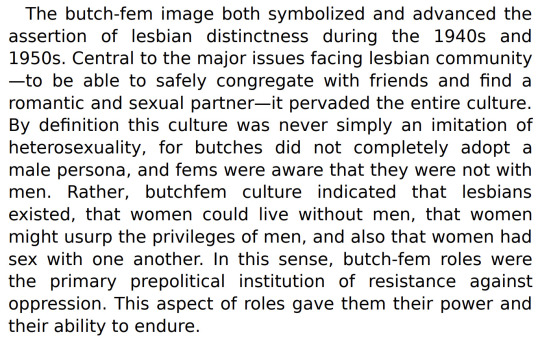
Illustrations by me, text from “The Butch-Fem Image as a Pre-political Form of Resistance,” Boots of Leather, Slippers of Gold: The History of a Lesbian Community by Elizabeth Lapovsky Kennedy and Madaline D. Davis
#1950s#words#history#boots of leather slippers of gold#drawing done in class bc i was bored lol#lesbian#butch lesbian#femme lesbian#butchfemme#lesbian history#butchfemme history
383 notes
·
View notes
Text
Obviously we have to wait for the video to know the story, but for anyone who’s studied any kind of social history/psychology/sociology/etc. And knows a little about the diagnosis of hysteria, Victorian mores, the use of lobotomies/shock therapy/etc to treat women who failed to live up to patriarchal ideals and the minimizing of women’s physical and mental health issues historically in the medical and psychiatric fields plus the old Hollywood of it all… the imagery is Telling The Story. I am fucking SEATED.
#I feel like I’ve been slammed back in time to being 19 in college right now lol#AND I SAID MY DEGREE WOULD NEVER COME IN HANDY LMAO#social psych social history film comms LOOK MA ALL MY CLASSES ARE GIVING ME AN A IN SWIFTIEISM#oh yeah I forgot history of western medicine I did that one too lol#the tortured poets department#fortnight mv
1K notes
·
View notes
Text
If you were watching Nosferatu and you noticed the doctors talking about how Ellen had too much blood and that's why she was acting crazy - let me explain why (and also how excited I am that it was included in the script).
From ancient Greece through the Renaissance, we believed in The Four Humors in medicine. Essentially, they thought there were four fluids in the body (blood, yellow bile, black bile, and phlegm) and they determined a person's temperament; an imbalance of them was believed causes illness. The Four Temperaments (based on the balance of their humors) are as follows:
Sanguine: Optimistic and social - (affected by blood)
Choleric: Short-tempered and irritable - (affected by yellow bile)
Melancholic: Analytical and quiet - (affected by black bile)
Phlegmatic: Relaxed and peaceful - (affected by phlegm)
They were also connected to celestial bodies, seasons, body parts, and stages of life. Here's a neat little chart:
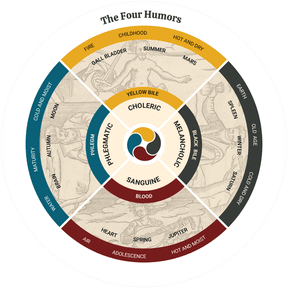
Ellen was already rather macabre, and as she spiraled she became less able to adhere to social convention; it makes sense that a doctor of the time would consider that to be an imbalance of her blood. It also feels worth stating that a sanguine temperament can be likened to the manic phase of a bipolar episode, which Ellen's symptoms certainly could have been indicative of.
I also think it's an interesting (though possibly pointless) connection that a sanguine temperament is linked to the heart, to adolescence, and to Spring.
The heart obviously links to Ellen as she's a hopeless romantic. Adolescence also connects due to not only her young age in the film, but the events causing Orlok's fascination with her happened when she was quite young as well. I would argue that you can tie Spring into Ellen's character also - she was blooming, transforming, awaiting a new breath of life (death?).
It made me so happy to see it included so casually, it was such an accurate portrayal of how medicine would have actually been practiced at the time and it wasn't made into a huge thing. It shows the appreciation and effort Eggers brings to his work.
I can absolutely see how you may just brush past that part (it was brief), or attribute it to vampirism, but it's actually a super cool little detail of our real life medical history!
#I got so excited in the theatre my sister was like wtf is wrong with you (when i explained later she was like oh wait that is cool lol)#im not a doctor and never took any classes in medicine.. just a nerd if im wrong about smth pls let me know#it reminds me of how trad chinese medicine balances the body but obv different#when i worked in TCM (not as a practitioner) i was like wait we're basing diagnoses off of hot and moist this is like Galen lol#ive not seen anyone else mention this and it adds some realism to the story#nosferatu#count orlok#ellen hutter#robert eggers#film analysis#film#horror films#gothic horror#medical history#fun facts#media analysis#my post
174 notes
·
View notes
Text
Tired Ghost
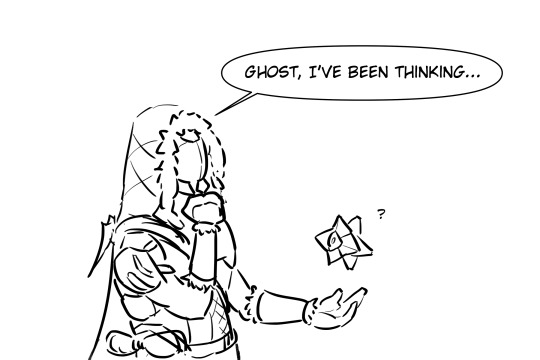
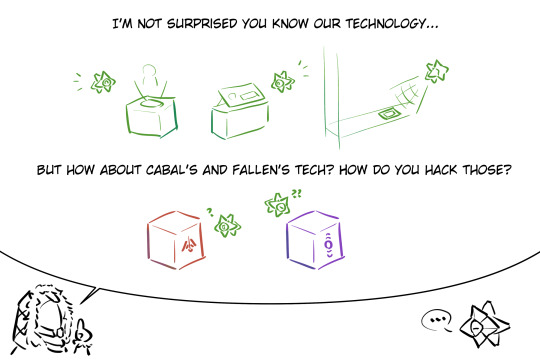
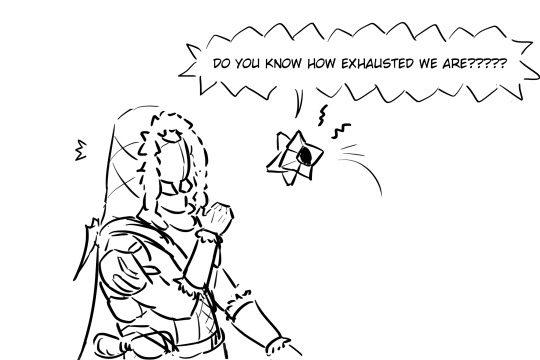
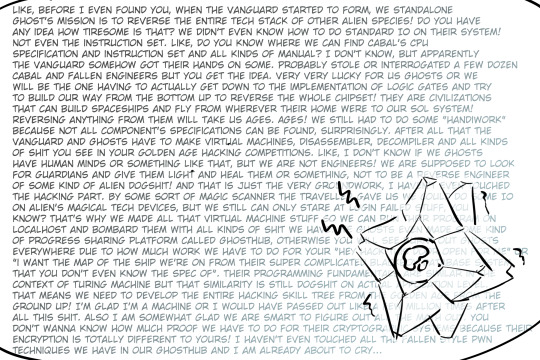
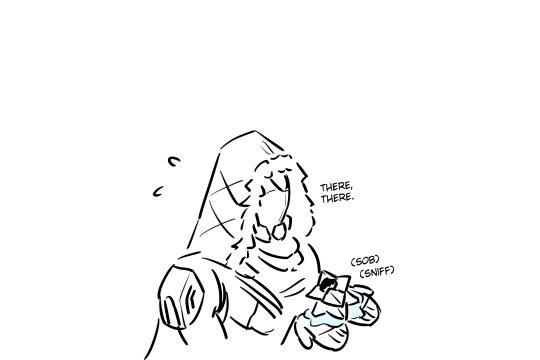
#i don't wanna spend too much time on this#(wrote an essay about how i thought vanguard hacking kit was developed)#yep that's not lorem ipsum#i just wanna see ghost complaining don't judge me too much#i didn't take history class in the ishtar collective (TM) those are all ooc don't actually read into that#if you actually know what im saying then you'd know i probably failed my computer security lesson#also the traveller probably gave them similar tech so their physical architecture should be similar#also ur a nerd lol#destiny 2#destiny hunter#destiny ghost#destiny 2 art#my art
821 notes
·
View notes
Text




Doodles! I don't like the ones of Jekyll very much because I can't seem to figure out how to draw him or his glorious hair. Sad! But I had to at least include the cat ears one.
#ignore the notes on the sides. they're not relevant they're just notes on my art history classes and my thoughts on the recent pages lol#my art#doodles#undescribed#the glass scientists#tgs#tgs hyde#tgs jekyll
110 notes
·
View notes
Note
I've seen a post you've reblogged and added to, among many things about women showing nipples. Can you recommend any ref material (articles, videos, etc.) are share your knowledge about this? Cause I'm curious about that, as nowadays going out in a shirt without a bra makes you indecent, while in like 90s it was okayish? I wonder how it was in previous centuries.
There is a really cool academic paper about bare breast dresses in 17th century England specifically. I think anyone can read it by creating a free account.
Abby Cox also has a good video about the cleavage during the past 500 years in which she goes through also the nip slip phenomena.
I don't have other sources that specifically focus on this subject, though many sources about specific decades touch on it, but I do have my primary source image collection, so I can sum up the history of the bare nipple.
So my findings from primary source images (I could be wrong and maybe I just haven't found earlier examples) is that the Venetians were the first ones to show the nipple for courtly fashion. At the same time in other places in Europe they sported the early Elizabethan no-boob style that completely covered and flattened the chest. In the other corners of Italy the necklines were also low but less extreme. Venetian kirtle necklines dropped extremely low as early as 1560s and they combined extremely sheer, basically see-through partlets with their kirtle. First example below is a 1565-70 portrait of a Venetian lady with the nipples just barely covered waiting slip into view with a movement of arm. There was an even more extreme version of this with the kirtle being literally underboob style, still with a sheer doublet. Though I believe this was not quite for the respectable ladies, since I have only seen it depicted on high class courtesans. They were not exactly respectable ladies, but they did have quite good social position. The second example is a 1570s depiction of a courtesan, which is revealed by the horned hairstyle. By the end of the century this underbust style with only see through fabric covering breasts, had become respectable. In the last example it's shown on the wife of the Venetian doge in 1597.

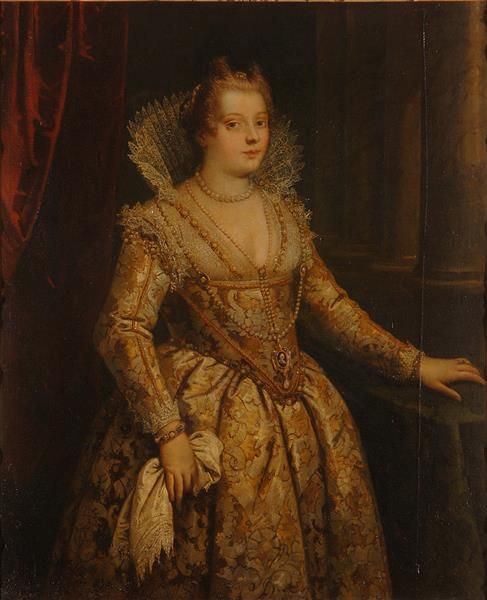
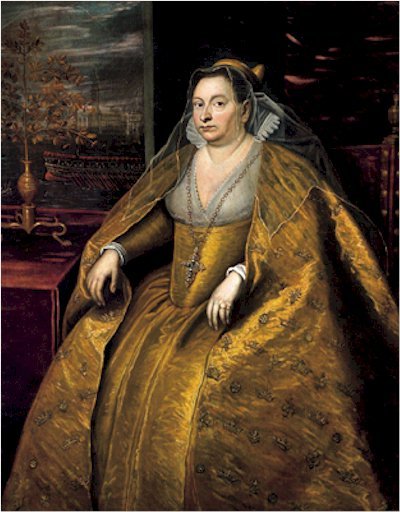
Around the same time, at the very end of 1500s, the extremely low cut bodice fashion enters rest of Europe. The low cut style was present in the bodices of all classes, but the nipple was really only an aristocrat thing. The lower classes would cover their breasts with a partlet, that was not sheer. Bare breast was ironically from our perspective a show of innocence, youthful beauty and virtue, and to pull off the style with respect, you also had to embody those ideals. Lower class women were considered inherently vulgar and lacking virtue, so a nipple in their case was seen as indecent. Bare boobs were also a sort of status symbol, since the upper class would hire wet nurses to breastfeed their children so they could show of their youthful boobs.
Covering partlets and bodices were still also used in the first decade of 1600s by nobles and the nip slip was mostly reserved for the courtly events. The first image below is an early example of English extremely low neckline that certainly couldn't contain boobs even with a bit of movement from 1597. The 1610s started around 5 decades of fashion that showed the whole boob. The first three were the most extreme. Here's some highlights: The second image is from 1619.
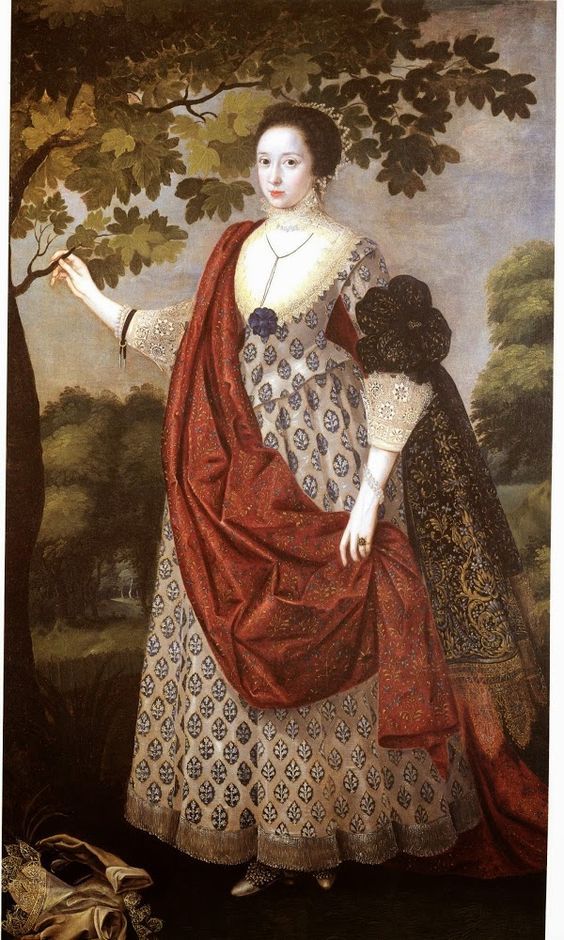
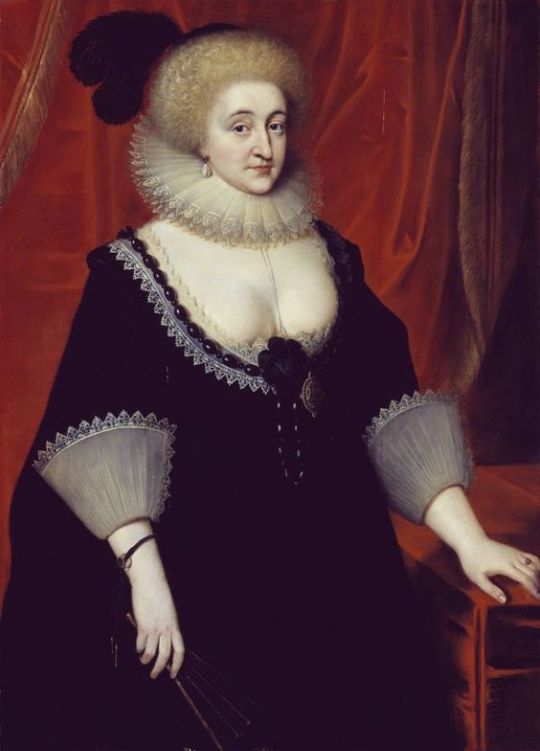
Here the first, very much showing nipples, from c. 1630. The second from 1632.
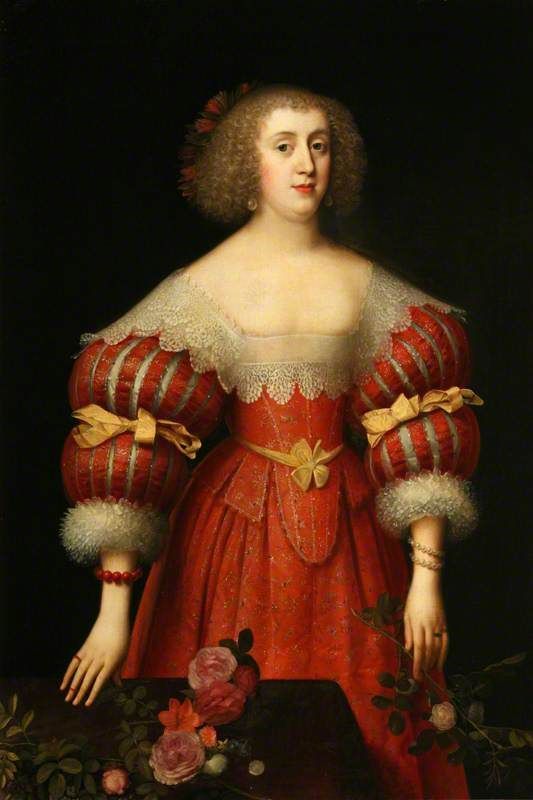

The neckline would slowly and slightly rise during the next decades, but nip slips were still expected. Here's an example from 1649 and then from 1650-55. In 1660s the neckline would get still slightly higher and by 1870s it was in a not very slippable hight. The necklines would stay low for the next century, though mostly not in boob showing territory, but we'll get there. But I will say that covering the neckline in casual context was expected. Boobs were mostly for fancy occasions. It was considered vain to show off your boobs when the occasion didn't call for it and covering up during the day was necessary for a respectable lady. You wouldn't want to have tan in your milk-white skin like a poor, and also they didn't have sun screen so burning was a reasonable concern.
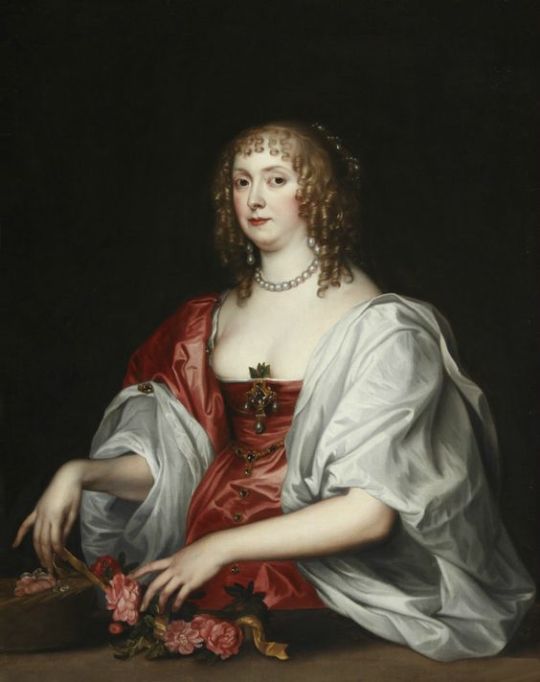
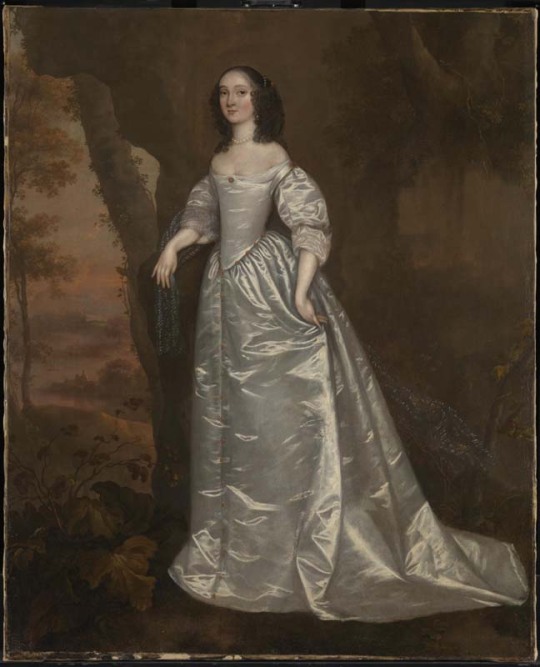
1720s to 1740s saw necklines that went to the nip slip territory, though they didn't go quite as low as 100 years earlier. The nipple was present in the French courtly fashion especially and rouging your nipples to enhance them was popular. Émilie Du Châtelet (1706-1749), who was an accomplished physicist and made contributions to Newtonian mechanics, was known in the French court to show off her boobies. An icon. Here she is in 1748. Here's another example from this era from 1728.
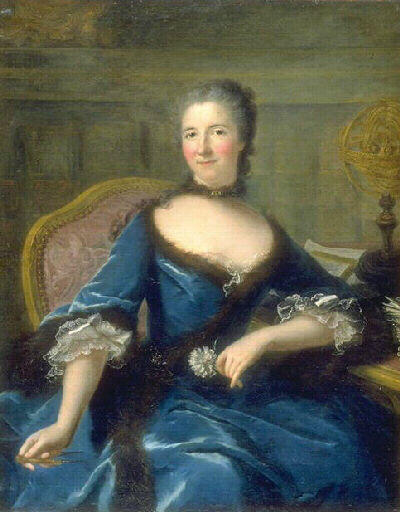
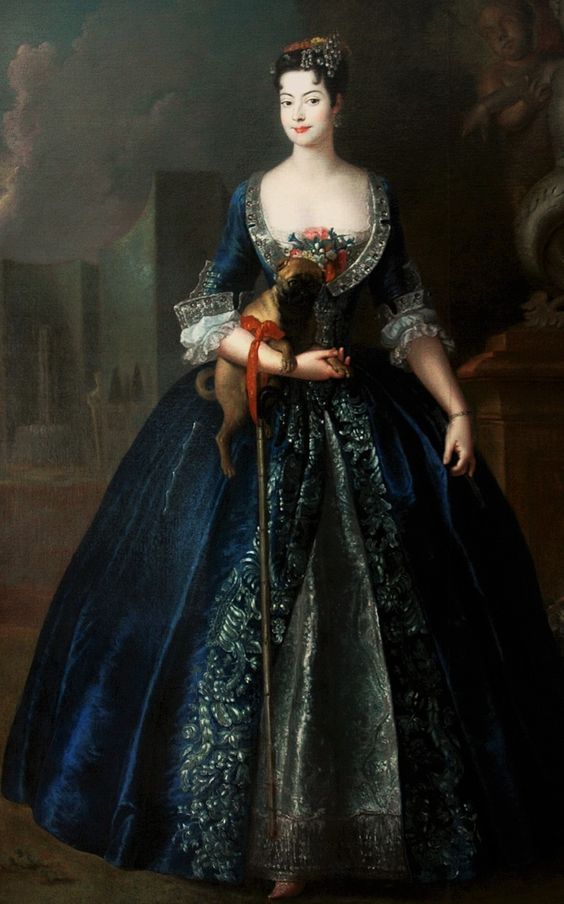
The Rococo neckline never got high, but in the middle of the century it was less low till 1770s when it plunged into new lows. In 1770s the fashion reached a saturation point, when everything was the most. This included boobs. The most boob visible. There was a change in the attitudes though. The visible boob was not a scandal, but it was risque, instead of sing of innocent and did cause offense in certain circles. I think it's because of the French revolution values gaining momentum. I talked about this in length in another post, mostly in context of masculinity, but till that point femininity and masculinity had been mostly reserved for the aristocracy. Gender performance was mostly performance of wealth. The revolutionaries constructed new masculinity and femininity, which laid the groundwork for the modern gender, in opposition to the aristocracy and their decadence. The new femininity was decent, moral and motherly, an early version of the Victorian angel of the house. The boob was present in the revolutionary imagery, but in an abstract presentation. I can't say for sure, but I think bare breasts became indecent because it was specifically fashion of the indecent French aristocracy.
Here's example somewhere from the decade and another from 1778. The neckline stayed quite low for the 1780s, but rose to cover the boobs for the 1790s.
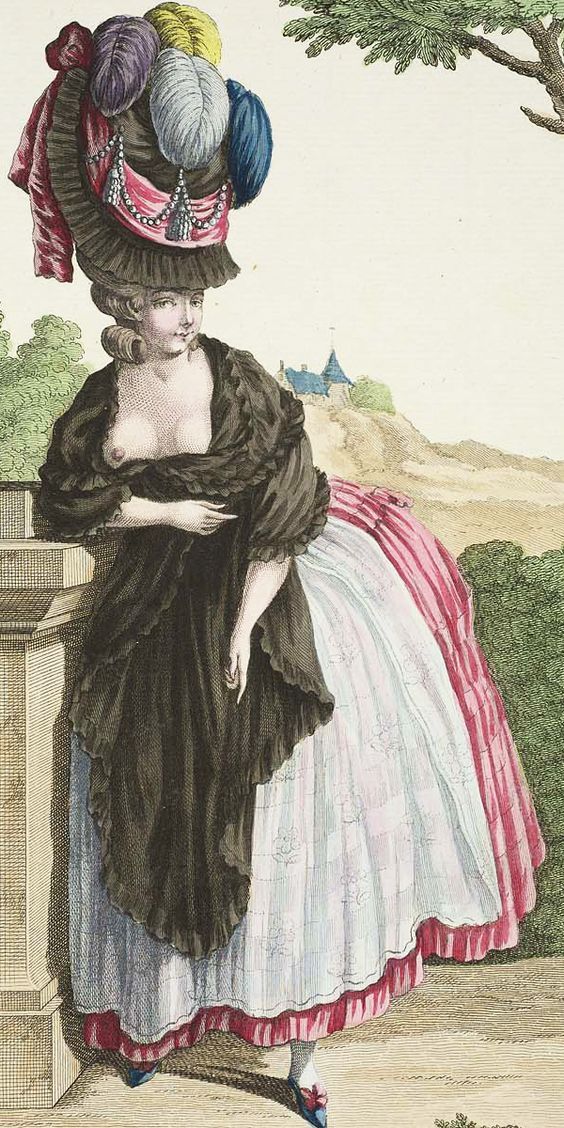
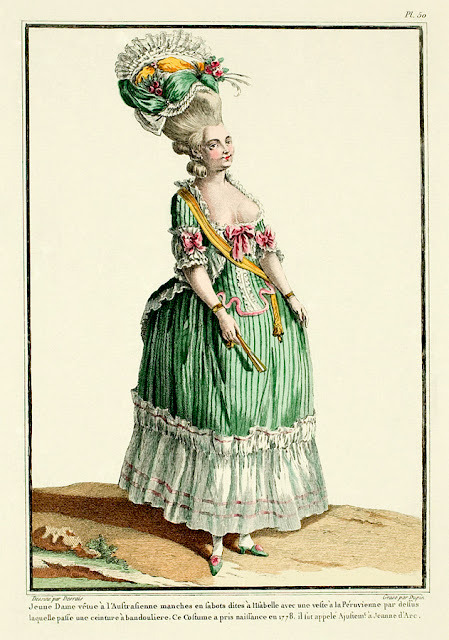
The nipple didn't stay hidden for long but made a quick comeback in the Regency evening fashion. It was somewhat scandalous by this point, and the nipple and sheer fabrics of the Regency fashion gained much scorn and satire. The styles that were in the high danger nip slip territory and those that allowed the nipple to show through fabric, were still quite popular. The sleeves had been mid length for two centuries, but in 1790s they had made a (rough) split between formal and informal wear. The evening sleeves were tiny, just covering the shoulder. Showing that would have been a little too much. Like a bare boob? A risque choice but fine. A shoulder? Straight to the horny jail. (I'm joking they did have sheer sleeves and sometimes portraits with exposed shoulder.) But long sleeves became the standard part of the day wear. Getting sun was still not acceptable for the same reasonable and unreasonable reasons. Day dresses did also usually have higher necklines or were at least worn with a chemisette to cover the neckline. Fine Indian muslin was a huge trend. It was extremely sheer and used in multiple layers to build up some cover. There were claims that a gust of wind would render the ladies practically naked, though because they were wearing their underclothing including a shift, which certainly wasn't made from the very expensive muslin, I'm guessing this was an exaggeration. Especially though in the first decade, short underboob stays were fairly popular, so combined with a muslin, nipples were seen. Here's an early 1798 example of exactly that. The short stays did disappear eventually, but in 1810s the extremely small bodices did provide nip slip opportunities, as seen in this 1811 fashion plate.


Victorian moralizing did fully kill the nip slip, though at least they were gender neutral about it. The male nipple was just as offensive to them. In 1890s, when bodybuilding became a big thing, bodybuilder men were arrested for public indecency for not wearing a shirt.
#there was also the new femininity aspect to regency nipple which had to do with breastfeeding becoming fashionable among upper class#it's about the whole motherly thing that came with the french revolution#i can't remember the book i read it from so i didn't go into it because i couldn't remember the details lol#but it did definitely have an effect to the fashion and to the perception of nipple#historical fashion#fashion history#history#dress history#fashion#answers#painting#fashion plate#renaissance fashion#elizabethan fashion#rococo fashion#baroque fashion#regency fashion#will tumblr prove itself to be again more prudish than elizabethans and label my post as mature content?#remains to be seen
562 notes
·
View notes
Text
why is francis framed so predatorily in the 'matters progressed' scene?
okay so. we all know that scene. the one where richard is high on demerol and francis kisses him and 'matters progressed' until charles interrupts them. one thing is that if you read it, especially out of context, it doesn't seem consensual. the scene is much beloved by papenathy shippers and yet here's richard saying repeatedly that he doesn't want it. so what about this is reading romantic?
personally, i think it's the classic bodice-ripper kidnapping fantasy. richard reminds me of a trend in romance readers (who are often women in the case of het romance), where their desires have been so shamed that they feel that in order to not feel guilty, they have to have the pretense of not wanting it. so, in tsh, we get a lot of 'i'm not gay, but he basically forced me' and 'i kissed him back, but i was really high so that must have been why'. within the context of the rest of the book, where he (albeit in an extremely repressed way) describes how attracted he is to the majority of the characters, francis included... hm. combined with the way he so fervently denies any and all attraction to him, despite us being in his head and knowing what he thinks of him, it doesn't read as much like coercion, but more like an attempt on richard's part to rewrite himself as having less 'blame' for the situation.
now. don't get it twisted. francis is absolutely not a close friend with the concept of consent. even if charles was 'manipulating' him, deliberately getting someone drunk so they'll have sex with you is fucked up and predatory. and he probably shouldn't have tried to sleep with richard in this scene, either, given he was obviously high. this is by far the worst thing about his character. but i think it's worth examining why papenathy shippers read this scene as something other than horrific on francis' part, and why non-papenathy shippers (& francis dislikers) don't draw much attention to that scene compared with the stuff with charles.
#joining the 'francis is not a good person' bandwagon as a francis lover is tricky lol.... and thats on morally grey characters#if this sounds familiar and ur in the greek class discord i've said it before on there#tsh#the secret history#francis abernathy#richard papen#papenathy
38 notes
·
View notes
Text
it's funny that not until i was flipping through reference material in the norton edition of the turn of the screw i got from the library did i make the connection that perhaps american literature's most famous ghost story was written by a guy whose brother was an active member of the society for psychical research
#i used to think william james was super famous bc he came up for me a lot in undergrad#but idk if that was due to a coincidence of classes i was taking#or bc he was affiliated with the university i was attending at the time#bc experiences sicne have taught me that he's not....#i mean i didn't think he was like freud or darwin but i would have placed him up there with... idk weber maybe?#anyway. he coined the phrase 'stream of consciousness'#and is credited according to wikipedia as first conceiving of the concept now referred to as neuroplasticity#(which i know bc seward identifies proving something VERY like neuroplasticity as one of van helsing's signature achievements#which caused me to look up the history of the concept lol)#and also he was p. into spiritual research and convinced of the authenticity of exactly one medium#i love the 19th century sorry i really do.....#also ok beloved is actually probably the most famous ghost story in american literature at this point#anyway i'n halfway through the book so far... p. good! spookier than i expected lol#bookblogging#turn of the screw#media 2k25#i'm sick but not too sick to spend at least some time reading instead of dicking around on reddit lol
23 notes
·
View notes
Text


A print from my high school French history book about what France owes to the Révolution and Napoléon.
(Yes, we had French history classes in French).
I remember very clearly that the teacher focused a lot on the causes and especially the consequences of the frev, showing that it had a positive impact on society.
The "Terror", Robespierre etc weren't even mentioned.
#frev#personal#french revolution#and then Italian history classes were back with thermidorian propaganda and I was so puzzled lol
21 notes
·
View notes
Text
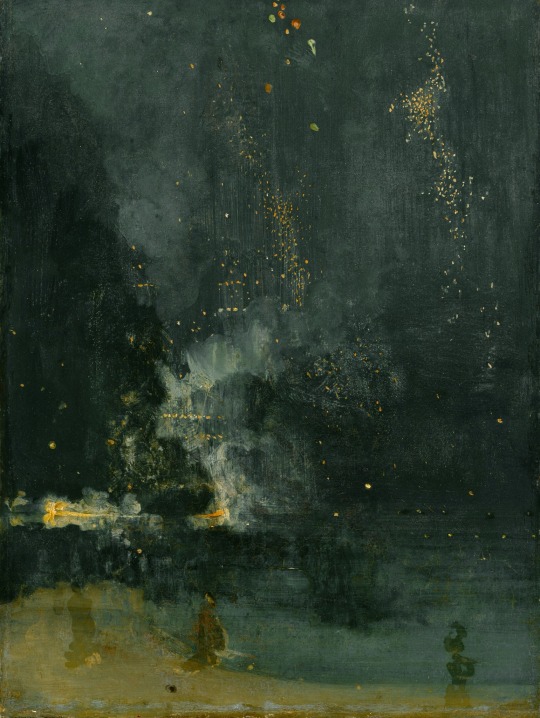

I discovered these paintings by James McNeill Whistler recently, Nocturne in Black and Gold: Falling Rocket (top) and Nocturne in Black and Gold: The Firewheel (bottom). I’m sharing them because they make me think of Nevermoor, as so many things do.
With paintings, a nocturne refers to the depiction of night. This is derived from the musical term, where a nocturne refers to a musical piece that is “inspired by, or evocative of, the night.” These both just come from the fact that “nocturne” essentially means “of the night”.
On a basic level, this just reminds me of Nevermoor by the aesthetics. The dreamy nighttime setting strikes me the most, but also the sparks of yellow fire that make me think of Wunder. Think of how many important scenes happen at night- Morrigan on Eventide, the Museum of Stolen Moments, and the Hollowpox in Courage Square. But the concept has me thinking, obviously, about the Wundrous Art of Nocturne. The only songs we know are Morrigan and Squall’s, who both chose nursery rhymes as their Nocture. Their choices make me think of lullabies, sung at night… and there’s lots to think about with that.
#does anyone else see or understand my vision…..#nevermoor#nevermoor in the wild#another post from my drafts cuz I feel bad I have no art to share#only art history classes I actually took was animation history and then ancient and medieval so most of my info or knowledge from#anything later relies on me looking it up and seeing what research and info is online and etc etc etc#anyways. love whenever magic (of the wundrous arts variety) in nevermoor is compared to art or the process of making art. <333#I need to make a Pinterest / some other sort of site where I can share everything visually that reminds me of nevermoor. but also filterabl#and also where I can add notes for why different stuff makes me think of nevermoor or what I associate it with…..#bc I’m often sharing architecture in the discord but I also am always bookmarking clothes and stuff that I don’t share lol#I saw two clocks the other day at a history museum and also an alway thinking abt the Prague astronomical clock so my brain is always like:#‘wow just like the skyfaced clock :) nevermoor :)#circling back if anyone knows some sort of site like Pinterest where you can have bunch of images with notes and also filter between#different attributes pls lmk. I’m not a coder so I can’t think how to make smthn like that myself lol#I started this post like a month ago that’s why I don’t have anything better to say besides ending with ‘much to think about’ lol
55 notes
·
View notes
Note
How do the padawans react to meeting their teachers’ families? As a teachers kid, my mom’s students were either fascinated by big kid that looks like teacher or skeptical that teachers actually had lives outside of class
you really have to think abt who the Jedi's family is. bc it's not just finding out your teacher has a life!! like ok ahsoka? has geriatric rex and arguably luke, cool enough. cal? his wife is the super cool Merrin who all the padawans love and his Greez is a cool uncle and great pilot who makes 10/10 snacks. ezra's family? all heroes of lothal, which is pretty damn cool but they're not AS widely known in the rebellion. still u have sabine who all the kids definitely idolise. and THEN YOU GET TO LUKE WHOSE ENTIRE FAMILY CONSISTS OF MAJOR HEROES OF THE REBELLION, INCLUDING THE LAST PRINCESS OF ALDERAAN. PLUS TWO FORMER SENATORS OF NABOO, THE HERO WITH NO FEAR (who definitely died in the clone wars we're not getting into that w kids) AND THEN EVENTUALLY THE MAND'ALOR.
needless to say this is less "woah my teacher has a life" and more "woah my teacher is related to everyone of any historical importance in the last 30 years"
#luke probably can't take history class cause he'd have to say “my sister” “my dad” etc on half the events#only gets worse when we get rey in the picture LOL#also hiiii fellow teacher's kid#thanks for the ask!#dinluke#< im solely tagging this bc i found it a year later and i want to find it again sometime
314 notes
·
View notes
Note
I would love to hear more about the 'Charles’s best-friend’s-brother elaboration' :D
Absolutely!! So I say elaboration bc it’s basically me making a fic out of this post of mine where I talk about Charles getting into ska punk from a friend’s older brother (and definitely having a crush on him but Charles doesn’t know that at the time ofc)
The whole idea came about when I was doing research for what concerts Charles could’ve realistically gone to (which I listed out in a different post here) and started realising that Charles is actually a few years too late for the peak of 2nd wave ska but dies just before 3rd wave ska begins!!!! I’ve seen some people try and have it as his dad getting him into the music when he was a kid but 1. I hate his dad and 2. His dad would’ve been too early for 2nd wave imo. So, to split that time difference, I came up with the best friend’s brother idea! I was also playing around with Charles having cousins who were into ska punk, or maybe running with some older friends, but this way I get to also explore unknowingly bi baby Charles 🩷💜💙
As for what I’ve got so far: I’ve got about 600 words and a vague outline and that’s about it 😅 I’ve written an intro from Charles’s POV (the whole fic will be third person limited---I’m trying to practice Charles’s voice!) as well as the beginnings of the scene where the DBDA (specifically Crystal) ask about how Charles got into ska punk and he ends up having some Realisations iykwim
With the outline I’ve also got the names and ages of the best friend and his brother, so Neville Brown (born 1973) and Roger Brown (born 1969) are in their early stages!!! I chose Brown since the original inspiration was Hobie Brown from ATSV, and then Neville is after Neville Staples from The Specials and Roger is after Ranking Roger from The Beat. I’m not super well versed in the subculture/genre (so if these people or bands are problematic someone lmk lol) but I am in a class on Punk culture this upcoming semester so I’m hopeful that will translate well for this fic!!!
Tysm for asking !!!!!!!!!! (and sorry that this is like a whole wall of text lmao I haven’t talked about this one much !!)
#unsure if i'll do established payneland or if I'll have it loop back around to modern day and have it be a getting together fic#depends on if I have Charles tell it all at once so the memory is basically the fic or if I space it out a bit#as always open for feedback and ideas !!#I figure this one will happen more during the spring with that class so I wouldn't expect it anytime soon lol#charles rowland my beloved#*slaps roof of the show/fandom* this bad boy can fit so much history in it#ask games#ask me things!#charles rowland bfb#haven't fully decided on the tag I'm gonna use but we'll roll with that for now#dead boy detectives#dbda#charles rowland#edwin payne#payneland#dead boy detective agency#crystal palace#niko sasaki#save dead boy detectives#dbda oc#dbda fanfic#dbda fic#my wips#writing wip#bisexual Charles Rowland
24 notes
·
View notes
Text
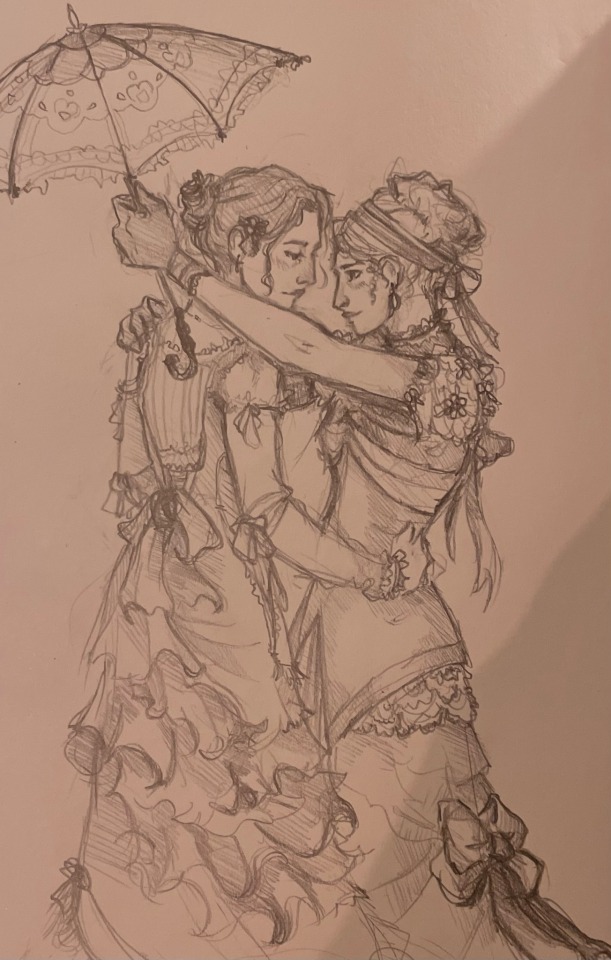
in another life
#THIS ISNT BAND OF BROTHERS SORRY#this is in fact. checks notes. clockwork angel fanart. the the real year of 2024. i know#i read this for a class and idk. whatever jem and will have going on… tessa honey don’t bother#jessamine was RIGHT THERE!!!! offering to RUN AWAY WITH YOU!!!#if only you’d known earlier about ur fucked up brother#anyways lol#back to bofb posting soon. thought i’d toss this out there bc it is 1878 lesbians and that’s like. most of y’all seem to like that#clockwork angel#clockwork prince#clockwork fanart#the mortal instruments#cassandra clare#jessamine lovelace#tessa gray#cirro sketches#history#1800s art#late 1800s
22 notes
·
View notes
Text
"Here's a cute video of a cherokee baby speaking cherokee, yay language!"
Randos on tumblr: "sucks that my ancestors killed so many of yall and nearly wiped out the language :/" "I want to see more celebration instead of colonization and murder, which is why I'm currently bringing up colonization and murder on a celebration post" "hate to see that the language is dying and is continuing to die and is being killed :/"
Like yall it's a cute baby. You can be happy and celebrate without going settler guilt in my activity
#like there are places to talk about the ramifications of colonization and continued colonization#but it gets tiring having it brought up constantly under a happy video of a cute baby speaking her language#you can also reblog it without announcing 'IM NOT NATIVE!!' lol#like. i guess its the 'only exposed to nstive stuff in history class and activism posts abt ongoing colonization#but never engages with actual regular native communities and celebrations of culture and language learning' type stuff ? idk
27 notes
·
View notes